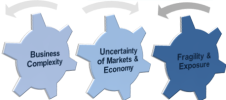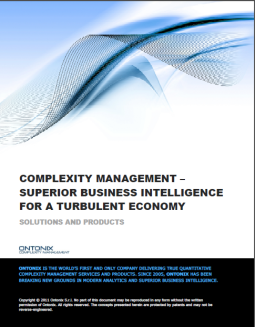Black Swans: A Corporate Governance “blind spot”
Monday, 15 November, 2010 Leave a comment
“FIT FOR RANDOMNESS” is all about accepting that complexity adds to the uncertainty – and, therefore, risk – of modern living. We CANNOT predict what will happen but that does not mean that we should not prepare, as best we can, to survive the unforeseen by building robustness [resilience or anti-fragility] into the complex, dynamic, systems upon which we depend.
Dr. James Carafano of the Heritage Foundation spoke to this issue at a congressional hearing on resilience in the homeland in 2008. He said, “The current paradigm of ‘protecting’ infrastructure is unrealistic. We should shift our focus to that of resiliency. Resiliency is the capacity to maintain continuity of activities even in the face of threats, disaster, and adversity.”
Any, self-respecting, C-Level Executive (or non-Exec.) worthy of the office, should assess and detail their strategy for corporate survival. Failure to do so is to expose the business, its stakeholders, professional reputation and with it, personal wealth, family and community stability to undue risk. From that perspective (alone) I tend beyond the questions (shown below) from the International Federation of Accountants.
I am used to getting “funny looks” when I suggest that QUANTITATIVE COMPLEXITY MANAGEMENT [QCM] from Ontonix is more than a means for an organisation to extend its “risk horizon” – beyond the scope of conventional ERM. QCM, or Advanced Risk Management, facilitates better, more consistent and robust, business [risk] decisions. In the process, securing that most precious of commodities, “competitive advantage”.
Here are some complexity facts from Ontonix.
How many organisations can answer – or have ever asked – this question?
How fast can you and your organization adapt?
5 minutes. 5 hours. Or 5 days.
An adaptive enterprise that is capable of rapidly adapting to a continuously changing "Operational Risk Ecosystem" within minutes or hours, will have the highest likelihood to survive. Days could mean the end of the relationship with customers, employees and your vital supply chain. Corporate obituaries are all too common soon after a significant business disruption. Whether physical, cyber or both, the adaptive enterprise is not only resilient but also possesses the most sought after business risk asset, an effective "Decision Advantage."
Randomness
There are plenty of references, in past blogs, to Nassim Taleb (NNT) and his books “The Back Swan” and “Fooled by Randomness”. He doesn’t need my input to enhance his reputation. However, I hope that any readers will take something worthwhile on the subject from the following extracts from an interesting blog:
Corporate Governance, Ostriches and Black Swans
A black swan is a highly improbable event with three principal characteristics: It is "unpredictable"*; it carries a massive impact; and, after the fact, we concoct an explanation that makes it appear less random, and more predictable, than it was. The astonishing success of Google was a black swan; so was 9/11. For Nassim Nicholas Taleb (author The Black Swan: The Impact of the Highly Improbable), black swans underlie almost everything about our world, from the rise of religions to events in our own personal lives.
*Unforeseen is NOT the same as unforeseeable!
Why do we not acknowledge the phenomenon of black swans until after they occur? Part of the answer, according to Taleb, is that humans are hardwired to learn specifics when they should be focused on generalities. We concentrate on things we already know and time and time again fail to take into consideration what we don’t know. We are, therefore, unable to truly estimate opportunities, too vulnerable to the impulse to simplify, narrate, and categorize, and not open enough to rewarding those who can imagine the “impossible.”
Black Swan: Strategy Execution for the “Outlier”
When Black Swan events occur, shareholders can suffer significant losses. Forbes magazine in their article,Of Brown Pelicans And Black Swans chronicled the financial impact of various corporate Black Swans–
|
Company |
Start Date |
End date |
Market cap |
Market cap |
Money Lost |
|
|
XOM |
Exxon Mobil |
3/24/89 |
4/10/89 |
55,275 |
52,170 |
3,105 |
|
MS |
Morgan Stanley |
9/10/01 |
9/17/01 |
45,171 |
39,259 |
5,912 |
|
BAC |
Bank of America |
9/10/01 |
9/17/01 |
92,439 |
87,147 |
5,291 |
|
MAR |
Marriott International, Inc |
9/10/01 |
9/17/01 |
9,996 |
7,892 |
2,104 |
|
BID |
Sotheby’s |
9/10/01 |
9/17/01 |
636 |
550 |
85 |
|
AXP |
American Express Company |
9/10/01 |
9/17/01 |
40,563 |
35,048 |
5,515 |
|
BK |
The Bank of New York Mellon Corporation |
9/10/01 |
9/21/01 |
27,269 |
22,555 |
4,714 |
|
XOM |
Exxon Mobil |
8/29/05 |
10/21/05 |
368,346 |
349,115 |
19,231 |
|
COP |
Conoco Phillips |
8/29/05 |
10/21/05 |
87,791 |
80,943 |
6,848 |
|
SCGLY |
Societe Generale SA (ADR) |
1/18/08 |
1/28/08 |
58,192 |
49,014 |
9,178 |
|
TM |
Toyota |
1/21/10 |
2/4/10 |
155,884 |
123,749 |
32,135 |
|
DLAKY |
Deutsche Lufthansa AG |
4/15/10 |
4/28/10 |
8,207 |
7,395 |
812 |
|
BAIRY |
British Airways |
4/15/10 |
4/28/10 |
4,338 |
3,952 |
386 |
|
BP |
BP |
4/22/10 |
6/17/10 |
186,431 |
99,273 |
87,158 |
The costs of Black Swans can be daunting.

For Corporate Governance, dealing with Black Swans is risk management. The Board is responsible for oversight and the strategic direction of the company— not execution. This means Board members should take on a devil’s advocate role by asking C-Level managers questions such as–
-
How will you make the strategic direction come alive?
-
Have you considered all financial, strategic, ethical and risk issues?
-
What is the worst that could go wrong and how will you manage the outcomes?
More insights for dealing with Black Swans are covered in the report Black Swans Do Exist published by International Federation of Accountants–
-
Directors should increase their focus on risk, and engage more in detailed appreciation and understanding of the risks in their company’s products and service areas. For the financial services industry, a solution could be for boards to establish a specialized risk committee, and consider the employment of an external risk specialist.
-
Black swans do, and will always, exist. Therefore, be much more alert to the fact that, even at the extreme end of risk possibility, things do actually happen.
-
Executive remuneration should be better aligned with the longer-term real performance (in terms of profitability, not sales volume) of the organization—for example, via deferred remuneration in the form of shares.
-
Governance issues are probably best tackled with a mixture of regulatory, investor, and board responsibility. To only look to investors being more active is unlikely to be effective.











